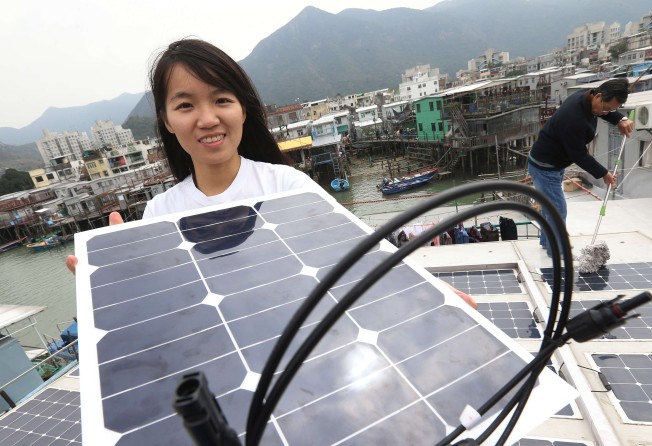
Tai O stilt homes to help prop up Hong Kong’s power grid with solar panel systems
Houses in Lantau fishing village get hi-tech upgrade with rooftop photovoltaic systems that can both supply users and feed excess energy back into public grid

Discount the growing throngs of tourists and worsening traffic and not too much has changed for Tai O’s indigenous townsfolk. Shrimp, fish and squid are still laid out to air dry under the sun as they have for generations.
But residents from one of the west Lantau town’s fishing villages are beginning to discover an additional use for sunshine through a recently launched renewable energy project developed with the help of green group WWF-Hong Kong.
Small-scale and lightweight photovoltaic systems, each with 20 to 25 solar panels, were installed on the rooftops of three stilt houses last summer, each with a two-kilowatt capacity capable of generating 2,000 to 2,500 kilowatt-hours of electricity a year.
Over a monitoring period in November and December, each system churned out about 125kWh of electricity per month.

That’s enough to meet about one third of the electricity needs per day of the average four-person household in Hong Kong, said Olivia To Pui-wai, WWF’s public engagement officer for climate.
“The success proves there is great potential feasibility and increasing public demand for implementing rooftop solar power in Hong Kong,” To said. The power produced by each system could potentially reduce bills by about HK$2,100 to HK$2,500 a year.
The systems are in the process of being connected to supplier CLP’s electricity grid. Currently, users do not know how much of the electricity they are using is clean or from the grid. With a grid connection, they could use the solar power directly or feed the renewable energy into the grid to offset their electricity costs.
“I was sceptical at first as it sounded all too simple, but if it really can help reduce fossil fuel use and emissions and help us save on our electricity bills, then it kills two birds with one stone,” said retired seafarer Leung Ming-chi, who owns one of the stilt homes running the system. But he admitted that climbing up to the roof regularly to clean the panels was a headache.
“We’ll have to wait about a year to see what the impact is on our electricity bills,” he said.
To urged the government to introduce feed-in tariffs, or payments to households feeding power into the grid from renewables, at higher than market rates to incentivise more private investment in distributed renewable systems and slash payback periods. A 20-panel system like Leung’s costs about HK$70,000. His was funded by WWF and their partners – and will see a long period of return on investment of about 30 to 35 years.
“A HK$4 per unit [feed-in tariff] will shorten the payback period to between eight and 10 years,” To said.
Islands District Council vice chair Randy Yu Hon-kwan, a Tai O native, said the idea for home solar stemmed from a more basic concern about the lack of nighttime illumination in the walkways of the iconic but primitive stilt homes, which are built above the waterways.
About 20 Tai O households have since expressed interest in the installations.
In its latest 2030+ climate change action report, the Environment Bureau admitted the city had a 3 to 4 per cent realisable renewable energy capacity and said it would explore the introduction of a feed-in tariff system during negotiations with the two power companies over the post-2018 scheme of control regulatory framework.
Renewable sources make up just 0.1 per cent of the city’s current electricity mix.